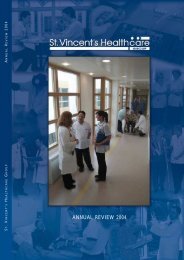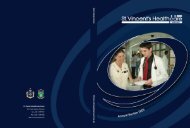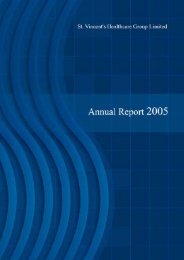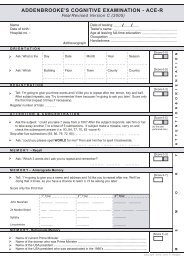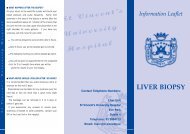ANNUAL REVIEW master Final3a - St Vincent's University Hospital
ANNUAL REVIEW master Final3a - St Vincent's University Hospital
ANNUAL REVIEW master Final3a - St Vincent's University Hospital
You also want an ePaper? Increase the reach of your titles
YUMPU automatically turns print PDFs into web optimized ePapers that Google loves.
<strong>St</strong>. Vincent’s Healthcare Group Limited - Annual Review 2007<br />
Education & Research<br />
transcription factor, NRF2 that regulates cytoprotective pathways is up-regulated in the livers of younger<br />
donors and that increased expression of this transcription factor means a better outcome post-transplant.<br />
Badar Zaman, Martin Leonard (Conway Institute, UCD), Elizabeth Ryan, Cormac Taylor (Conway<br />
Institute, UCD), Justin Geoghegan, Cliona O’Farrelly.<br />
Hepatic Malignancy<br />
CD1d is a restriction element for natural killer (NK) T cells, a sub-population of lymphocytes expressing a T<br />
cell receptor together with NK cell markers. CD1d molecules bind and present lipids to these NKT cells<br />
resulting in activation and production of cytokines. Immune regulatory functions such as development of<br />
tolerance, regulation of autoimmunity, and potent antitumour and antiviral activities have been ascribed to<br />
NKT cells. The aim of this study is to investigate the role of CD1d isoforms in regulating immune responses<br />
to malignancy.<br />
Margaret O’Brien, Emma McGrath, Cliona O’Farrelly<br />
HCV & It’s effect on Bone Metabolism<br />
Does chronic HCV infection increase the risk for the development of Osteoporosis?<br />
Osteopenia (thin bones) and osteoporosis (brittle bones) are common among patients with chronic liver<br />
disease. The purpose of this study is to investigate the frequency of bone disease in a group of women<br />
infected with hepatitis C virus (HCV) via contaminated anti-D. The underlying mechanisms by which chronic<br />
HCV may cause osteoporosis are not fully understood, but individuals chronically infected with HCV have<br />
ongoing inflammation. We want to determine if this inflammation causes an increase in bone breakdown.<br />
Bone mineral density and markers of inflammation in individuals with persistent infection will be compared<br />
to those who have cleared the infection.<br />
Kavin Nanda, Elizabeth Ryan, Barbara Murray, Malachi McKenna, John Hegarty, Cliona O’Farrelly<br />
IL-10 and TGF-‚ mediated suppression of antigen-specific Th1 and Th17 responses during HCV infection<br />
We have shown that antigen-specific IL-10-secreting regulatory T (Treg) cells are induced in patients<br />
chronically infected with HCV. We found that HCV nonstructural protein 4 (NS4) induces IL-10, and inhibits<br />
IL-12 production by monocytes. We also found that PBMC from HCV infected patients secreted significant<br />
concentrations of IL-10, but low concentrations of IFN-γ and IL-17 in response to NS4. Addition of a<br />
neutrailizing antibody to IL-10 significantly enhanced NS4-specific IFN-γ, but not IL-17 production. In<br />
contrast, IL-17 was enhanced by neutralisation of TGF-β. Our findings suggest that HCV subverts virusspecific<br />
Th1 responses through the induction of IL-10 from monocytes and Treg cells and suppresses Th1<br />
and Th17 cells through TGFβ‚ production. This may in part explain the failure to clear the chronic infection.<br />
Aileen Rowan (TCD), Elizabeth Ryan, John Hegarty, Cliona O’Farrelly, Kingston Mills (TCD)<br />
Cytokine and chemokine signatures predictive of the response of HCV patients to therapy<br />
IFN-α in combination with Ribavirin is the current standard treatment for chronic HCV infection. However,<br />
more than 50% of patients do not respond to this combination therapy and suffer significant side effects<br />
unnecessarily. We propose to design an assay based on these characteristic signatures that will be used to<br />
predict the potential efficacy of IFNα/Ribavirin therapy on an individual patient basis, prior to commencement<br />
of treatment. Chemokines and cytokines that are over- or under-expressed in non-responders will be potential<br />
Return to Contents<br />
34




